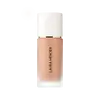Laura Mercier Real Flawless Weightless Perfecting Waterproof Foundation Versus Etude House Double Lasting Vegan Cover Foundation
What's inside
What's inside
 Key Ingredients
Key Ingredients

 Benefits
Benefits

 Concerns
Concerns

 Ingredients Side-by-side
Ingredients Side-by-side

Isododecane
EmollientIsodecyl Neopentanoate
EmollientHydrogenated Polyisobutene
EmollientHydrogenated Polycyclopentadiene
Hydrogenated Didecene
Skin ConditioningSilica
AbrasivePolyglyceryl-3 Diisostearate
EmulsifyingHydrogenated Styrene/Isoprene Copolymer
Dicalcium Phosphate
AbrasiveDisteardimonium Hectorite
StabilisingCellulose
AbsorbentLauryl PCA
HumectantTheobroma Cacao Seed Extract
AntioxidantHydrogenated Lecithin
EmulsifyingCamellia Oleifera Seed Oil
Skin ConditioningWater
Skin ConditioningPentaerythrityl Tetra-Di-T-Butyl Hydroxyhydrocinnamate
AntioxidantTocopheryl Acetate
AntioxidantButylene Glycol
HumectantIron Oxides
CI 77891
Cosmetic ColorantIsododecane, Isodecyl Neopentanoate, Hydrogenated Polyisobutene, Hydrogenated Polycyclopentadiene, Hydrogenated Didecene, Silica, Polyglyceryl-3 Diisostearate, Hydrogenated Styrene/Isoprene Copolymer, Dicalcium Phosphate, Disteardimonium Hectorite, Cellulose, Lauryl PCA, Theobroma Cacao Seed Extract, Hydrogenated Lecithin, Camellia Oleifera Seed Oil, Water, Pentaerythrityl Tetra-Di-T-Butyl Hydroxyhydrocinnamate, Tocopheryl Acetate, Butylene Glycol, Iron Oxides, CI 77891
Water
Skin ConditioningCI 77891
Cosmetic ColorantDiphenylsiloxy Phenyl Trimethicone
Skin ConditioningMethyl Trimethicone
Skin ConditioningButylene Glycol
HumectantHomosalate
Skin ConditioningIsododecane
EmollientTitanium Dioxide
Cosmetic ColorantCaprylyl Methicone
Skin ConditioningAcrylates/Polytrimethylsiloxymethacrylate Copolymer
Skin ConditioningLauryl Polyglyceryl-3 Polydimethylsiloxyethyl Dimethicone
Skin ConditioningPolyglyceryl-6 Polyricinoleate
EmulsifyingCI 77492
Cosmetic ColorantMica
Cosmetic Colorant1,2-Hexanediol
Skin ConditioningDisteardimonium Hectorite
StabilisingSodium Chloride
MaskingAluminum Hydroxide
EmollientPolyglyceryl-2 Isostearate
EmulsifyingVinyl Dimethicone/Methicone Silsesquioxane Crosspolymer
Silica
AbrasiveCI 77491
Cosmetic ColorantStearic Acid
CleansingTriethoxycaprylylsilane
CI 77499
Cosmetic ColorantCaprylyl Glycol
EmollientGlyceryl Caprylate
EmollientTrihydroxystearin
Skin ConditioningMethicone
EmollientXanthan Gum
EmulsifyingDisodium EDTA
Tocopherol
AntioxidantWater, CI 77891, Diphenylsiloxy Phenyl Trimethicone, Methyl Trimethicone, Butylene Glycol, Homosalate, Isododecane, Titanium Dioxide, Caprylyl Methicone, Acrylates/Polytrimethylsiloxymethacrylate Copolymer, Lauryl Polyglyceryl-3 Polydimethylsiloxyethyl Dimethicone, Polyglyceryl-6 Polyricinoleate, CI 77492, Mica, 1,2-Hexanediol, Disteardimonium Hectorite, Sodium Chloride, Aluminum Hydroxide, Polyglyceryl-2 Isostearate, Vinyl Dimethicone/Methicone Silsesquioxane Crosspolymer, Silica, CI 77491, Stearic Acid, Triethoxycaprylylsilane, CI 77499, Caprylyl Glycol, Glyceryl Caprylate, Trihydroxystearin, Methicone, Xanthan Gum, Disodium EDTA, Tocopherol
 Reviews
Reviews

Alternatives
Ingredients Explained
These ingredients are found in both products.
Ingredients higher up in an ingredient list are typically present in a larger amount.
Butylene Glycol (or BG) is used within cosmetic products for a few different reasons:
Overall, Butylene Glycol is a safe and well-rounded ingredient that works well with other ingredients.
Though this ingredient works well with most skin types, some people with sensitive skin may experience a reaction such as allergic rashes, closed comedones, or itchiness.
Learn more about Butylene GlycolCi 77891 is a white pigment from Titanium dioxide. It is naturally found in minerals such as rutile and ilmenite.
It's main function is to add a white color to cosmetics. It can also be mixed with other colors to create different shades.
Ci 77891 is commonly found in sunscreens due to its ability to block UV rays.
Learn more about CI 77891Disteardimonium Hectorite comes from the clay mineral named hectorite. It is used to add thickness to a product.
It can also help stabilize a product by helping to disperse other ingredients.
Hectorite is a rare, white clay mineral.
Learn more about Disteardimonium HectoriteIsododecane is a fragrance, emollient, and solvent.
As an emollient, it helps your skin stay soft and hydrated. Emollients help trap moisture into your skin.
Isododecane's role as a solvent makes it a great texture enhancer. It spreads smoothly on skin and does not leave a sticky feeling behind. Isododecane also helps prevent color transfer in makeup products.
Isododecane is not absorbed into skin.
Learn more about IsododecaneSilica, also known as silicon dioxide, is a naturally occurring mineral. It is used as a fine, spherical, and porous powder in cosmetics.
Though it has exfoliant properties, the function of silica varies depending on the product.
The unique structure of silica enhances the spreadability and adds smoothness, making it a great texture enhancer.
It is also used as an active carrier, emulsifier, and mattifier due to its ability to absorb excess oil.
In some products, tiny microneedles called spicules are made from silica or hydrolyzed sponge. When you rub them in, they lightly polish away dead skin layers and enhance the penetration of active ingredients.
Learn more about SilicaWater. It's the most common cosmetic ingredient of all. You'll usually see it at the top of ingredient lists, meaning that it makes up the largest part of the product.
So why is it so popular? Water most often acts as a solvent - this means that it helps dissolve other ingredients into the formulation.
You'll also recognize water as that liquid we all need to stay alive. If you see this, drink a glass of water. Stay hydrated!
Learn more about Water